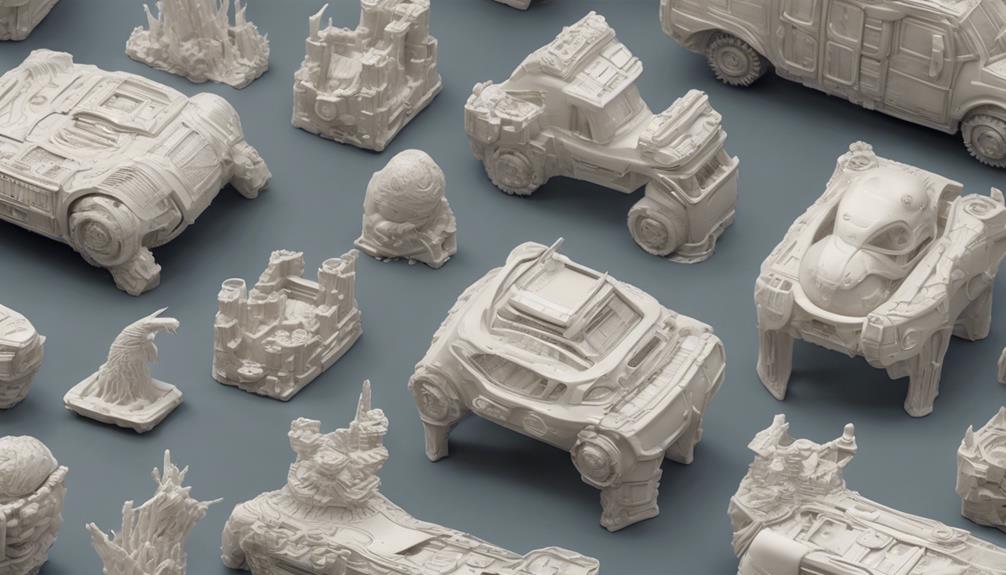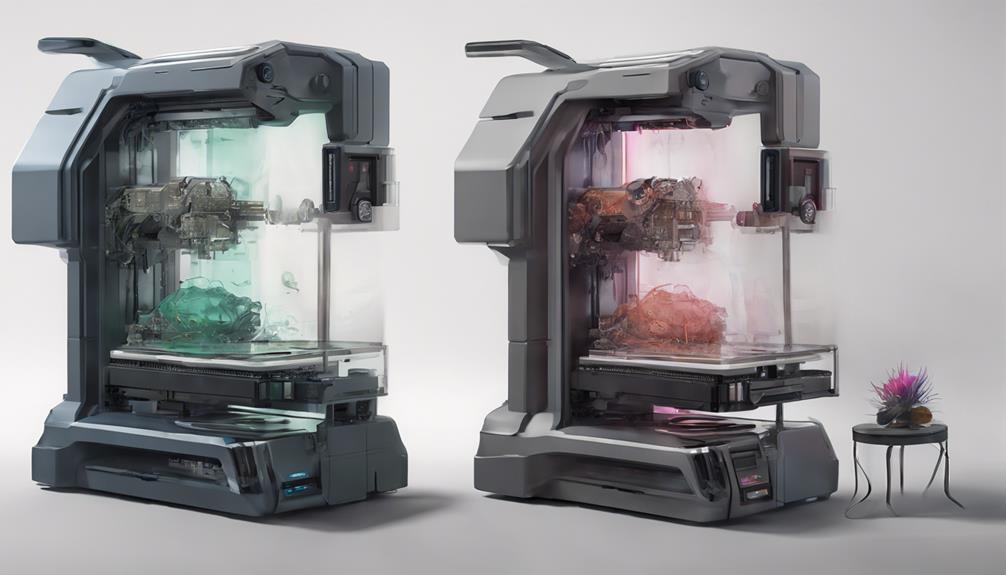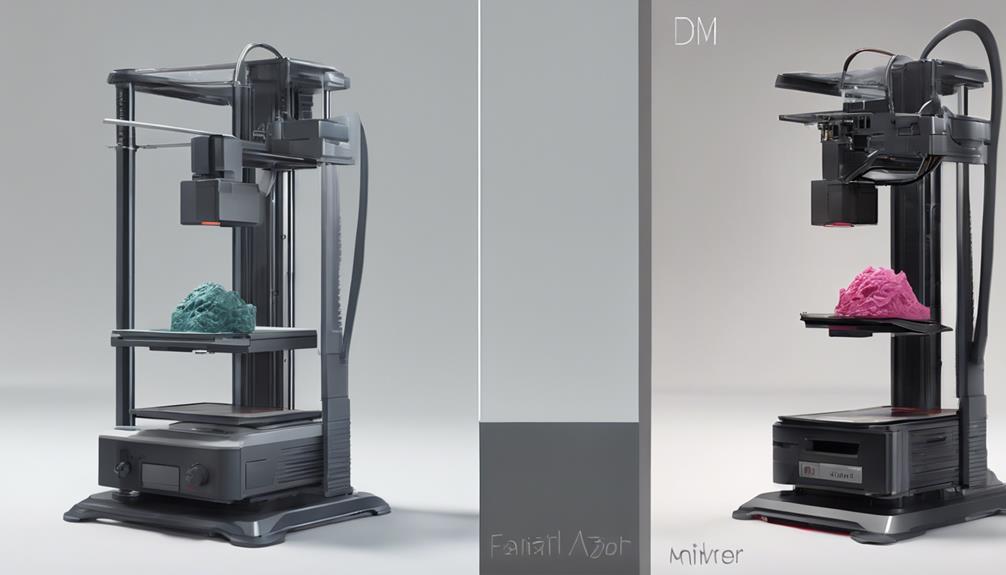In the domain of 3D printing, the debate between resin and FDM printers has sparked numerous discussions among enthusiasts and professionals alike. While both technologies have their strengths and weaknesses, the ultimate choice often hinges on the unique requirements of each project. As we explore the intricacies of resin versus FDM printers, a deeper understanding of their capabilities and limitations emerges, shedding light on which one reigns supreme in the world of additive manufacturing.
Technology Differences

In the domain of additive manufacturing, the fundamental divergence between resin and FDM printers lies in their distinct technological mechanisms. FDM printers, also known as Fused Filament Fabrication, operate by melting thermoplastic polymer filaments through a hot nozzle to create layers.
On the other hand, resin printers utilize photopolymer resin cured by ultraviolet light to form objects through techniques like SLA, DLP, and MSLA. This discrepancy in technology affects various aspects of the printing process, including print quality, material compatibility, and post-processing requirements.
Understanding these core technological disparities is essential for selecting the most suitable 3D printing method based on specific project requirements and desired outcomes.
Print Quality and Materials
Print quality and material characteristics play pivotal roles in distinguishing between resin and FDM 3D printers. Resin printers generally offer higher resolution and precision prints with a more uniform finish compared to FDM.
However, FDM printers provide a wider range of material options, colors, and types to choose from, while resin printing has limited material choices. It is important to note that resin prints may weaken over time due to UV exposure.
Despite this, the choice between resin and FDM printers ultimately depends on the specific requirements of the project, with resin printers excelling in detail and batch printing speed, and FDM printers being more cost-effective and easier to maintain.
Build Volume and Speed

When considering 3D printing technologies, the build volume and printing speed are important factors that greatly impact the efficiency and practicality of the printing process.
Resin printers generally have smaller build volumes compared to FDM printers, making them more suitable for smaller objects. However, resin printers are faster in operation due to their ability to solidify entire layers at once.
On the other hand, FDM printers are better suited for larger prints due to their larger build volumes, allowing for the production of bigger objects.
This difference in build volume and speed between resin and FDM printers directly affects the types and sizes of objects that can be efficiently produced using each technology.
Maintenance and Cost Analysis
Maintenance and cost analysis of 3D printers reveals important insights into the operational efficiency and financial considerations associated with resin and FDM technologies. Resin printers typically have fewer mechanical parts requiring adjustment compared to FDM printers, which often need maintenance such as unclogging nozzles and adjusting belts. However, resin printers tend to be more expensive to maintain due to the costlier parts involved.
On the other hand, FDM printers generally have lower acquisition and maintenance costs. When it comes to consumables, filament for FDM printers costs around $20 per 1kg spool, while resin for resin printers is pricier. These factors play a significant role in the overall cost efficiency of choosing between resin and FDM technologies.
Choosing the Right 3D Printer

Considering the operational efficiency and financial implications highlighted in the maintenance and cost analysis of 3D printers, making an informed choice between resin and FDM technologies involves a meticulous evaluation of specific functional requirements and technological capabilities.
Resin printers, with their higher detail and faster batch printing capabilities, are suitable for applications requiring intricate designs. On the other hand, FDM printers, being more cost-effective and easier to maintain, are preferable for projects prioritizing affordability and simplicity.
When choosing the right 3D printer, it is essential to create a criteria list that considers factors such as speed, accuracy, cost, and the nature of the intended prints. By objectively weighing the pros and cons of each technology, a tailored decision can be made to meet individual project needs.
Frequently Asked Questions
Can Resin Prints Be Painted Easily After the Curing Process?
After the curing process, resin prints can be painted easily. Guarantee proper cleaning and priming of the print surface for best adhesion. Use acrylic paints or other compatible materials. Allow the paint to fully dry before handling the printed object.
Do FDM Printers Produce Noticeable Layer Lines on Prints?
FDM printers can produce noticeable layer lines on prints, affecting surface smoothness. The layer lines are more pronounced in prints with larger layer heights. Proper calibration, using smaller layer heights, and post-processing techniques like sanding can reduce the visibility of layer lines.
Are Resin Printers Suitable for Functional Prototypes or Just Visual Models?
Resin printers are suitable for creating both functional prototypes and visual models. They offer high resolution and precision, making them ideal for intricate designs. However, resin prints may be weaker over time due to UV exposure, requiring consideration for long-term functionality.
How Does the Choice of Filament or Resin Affect Print Durability?
The choice between filament and resin greatly impacts print durability. Filament prints tend to be more durable over time than resin prints due to the latter's susceptibility to weakening from UV exposure. Consider material characteristics carefully for longevity.
Is It Possible to Use Third-Party Materials With Both FDM and Resin Printers?
When exploring the compatibility of third-party materials with FDM and resin printers, it is crucial to take into account factors like filament diameter, resin viscosity, and curing requirements. Always refer to manufacturer guidelines for best results.
Conclusion
To sum up, resin and FDM printers differ in technology, print quality, materials, build volume, speed, maintenance, and cost. When selecting between the two, it is crucial to ponder these factors thoughtfully.
Resin printers excel in detail and precision, while FDM printers offer a wider range of material options. Ultimately, the right 3D printer choice depends on the specific needs of the project at hand.